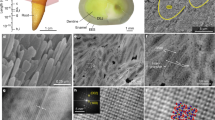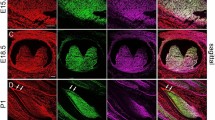Abstract
MAMMALIAN dentine consists mainly of hydroxyapatite crystallites with an average size of about 0.03µ1, and collagen fibres. If the latter are removed from a dentine section and the preparation embedded in a medium with a refractive index high enough to eliminate ‘form’ birefringence, the optical properties of the mineral are then seen, and it has been shown that the crystallites are orientated in definite patterns2. They may lie with their optic axes parallel with the original direction of the collagen fibres, parallel with the dentine tubules, or they may be ‘spheritically’ orientated.
This is a preview of subscription content, access via your institution
Access options
Subscribe to this journal
Receive 51 print issues and online access
$199.00 per year
only $3.90 per issue
Buy this article
- Purchase on Springer Link
- Instant access to full article PDF
Prices may be subject to local taxes which are calculated during checkout
Similar content being viewed by others
References
Thewlis, J., Proc. Phys. Soc., 51 (1939).
Keil, A., Z. Zellforsch., 21 (1934); 25 (1936).
Author information
Authors and Affiliations
Rights and permissions
About this article
Cite this article
POOLE, D. Crystallite Orientation in the Tooth Dentine of Macropus . Nature 177, 485–486 (1956). https://doi.org/10.1038/177485a0
Issue Date:
DOI: https://doi.org/10.1038/177485a0
Comments
By submitting a comment you agree to abide by our Terms and Community Guidelines. If you find something abusive or that does not comply with our terms or guidelines please flag it as inappropriate.



